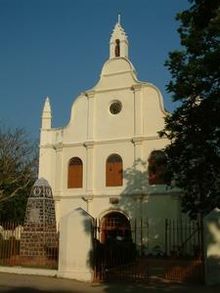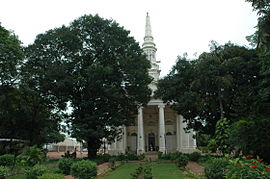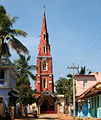- Church of South India
-
Church of South India 
Logo of the Church of South India Classification Protestant Orientation Anglican Polity Episcopal Moderator The Most Revd S. Vasantha Kumar Associations Anglican Communion,
World Council of Churches,
World Alliance of Reformed Churches,
Christian Conference of Asia,
Communion of Churches in India,
National Council of Churches in IndiaGeographical areas Andhra Pradesh, Karnataka, Kerala, Tamil Nadu, and Sri Lanka Origin September 1947
ChennaiMerge of Anglican and Protestant including some Methodist, Presbyterian and Baptist Congregations 14,000 [1] Members 3.8 million [1] Ministers 1,214 [2] Hospitals 104 [1] Secondary schools 2000 schools, 130 colleges Part of a series on Christianity
in India
Background People - St. Thomas the Apostle
- St. Francis Xavier
- St. Gonsalo Garcia
- Devasahayam Pillai
- St. Alphonsa Muttathupadam
- Thomas of Cana
- Mother Teresa
- Palackal Thoma Malpan
- Mar Augustine Kandathil
- Mar Sapor and Prodh
- Marthoma Metrans
- St. Gregorios of Parumala
- St. Baselios Eldho
- Fr. Kuriakose Elias Chavara
- Fr. Varghese Payapilly Palakkappilly
- Mgr. Joseph C. Panjikaran
- William Carey
Churches - St. Thomas Christians:
- Malankara (historical)
- Chaldean Syrian
- Jacobite Syrian
- Malankara Orthodox Syrian
- Malabar Independent Syrian
- Mar Thoma
- St. Thomas Evangelical
- Syro-Malabar Catholic
- Syro-Malankara Catholic
- Latin Rite:
- Latin Catholic
- Protestant denominations:
- Andhra Evangelical Lutheran
- Church of North India
- Church of South India
- Garo Baptist
- Pentecostal Church of God
- North Bank Baptist Christian
- Northern Evangelical Lutheran
- Presbyterian
- The Pentecostal Mission
- Seventh-day Adventist
- True Jesus
- United Evangelical Lutheran
Indian Christianity portal The Church of South India (commonly known as CSI) is the successor of the Church of England in India. It came into being in 1947 as a union of Anglican and Protestant churches in South India. With a membership of over 3.8 million, it is India's second largest Christian church after the Roman Catholic Church in India.[3] CSI is one of four united churches in the Anglican Communion.
The inspiration for the Church of South India was born from ecumenism and inspired by the words of Jesus Christ as recorded in the Gospel of John, 17.21
That they all may be one; as thou, Father, art in me, and I in thee, that they also may be one in us: that the world may believe that thou hast sent me.
That they all may be one is also the motto of the Church of South India.[1]
Contents
History
The CSI was inaugurated on 27 September 1947 at St. George's Cathedral Chennai, only a month after India achieved its independence from the United Kingdom. It was formed from the union of the South India United Church (itself a union of churches from the Congregational, Presbyterian and Reformed traditions) and the southern provinces of the Anglican Church of India, Pakistan, Burma and Ceylon and the Methodist Church of South India.[4] In the 1990s, a small number of Baptist and Pentecostal churches also joined the union.[1]
The presiding bishop of the inaugural function was the Rt Revd C. K. Jacob of the Anglican Diocese of Travancore and Cochin. A vast congregation gathered in the cathedral at Madras from all over the world. The following historical declaration made by Bishop Jacob at the inaugural.[5]
"Dearly beloved brethren, in obedience to the Lord Jesus Christ the head of the church, who on the night of his passion prayed that his disciples might be one, and by authority of the governing bodies of the uniting churches whose resolutions have been read in your hearing and laid in your prayer before Almighty God; I do hereby declare that these three churches, namely - the Madras, Madura, Malabar, Jaffna, Kannada, Telugu, Travancore Church councils of the South India United Church; the Methodist Church of South India, Trichinopoly, Hyderabad and Mysore districts; the Madras, Travancore and Cochin, Tinnevelly and Dornakal dioceses of the Churches of India, Burma and Ceylon; are become one Church of South India, and these bishops, presbyters, deacons and probationers who have assented to the basis of union and accepted the constitution of the Church of South India, whose names are laid upon this holy table, are bishops, presbyters and deacons of this church. In the name of the Father, and the Son, and the Holy Spirit, Amen."[5]
Discussions about the merging of South India's Protestant denominations began at a 1919 conference at Tranquebar (today known as Tharangambadi). This famous conference on church union is known as Tranquebar 1919.[6] One of the main leaders of this conference and later negotiations was Bishop V. S. Azariah of the Dornakal diocese, who was the first Indian bishop of the Anglican Church. The Church of South India is considered the result of twenty-eight years of prayers and discussions. By the independence of India in 1947, the union was achieved and the CSI officially established.
The inauguration of the Church of South India opened a new chapter in the history of the churches. This was the first time in history such a union was realised between episcopal and non-episcopal churches. By this union four traditions came together, i.e., Anglican (Episcopal), Congregational, Presbyterian, and Methodist.
One of the three churches to come into the Church of South India was the South India United Church (S.I.U.C.). S.I.U.C. was formed in 1908. This was a union between Congregationalists and Presbyterians. The Basal Mission, district of Malabar also joined the S.I.U.C. in 1919.
When C.S.I. was inaugurated there were fourteen dioceses. Today the church has twenty-two dioceses and more than 2 million members. There are eight dioceses in Tamil Nadu, six in Andhra Pradesh, four in Kerala, three in Karnataka, and one in Sri Lanka.
Logo
The logo of the CSI is a cross superimposed on a stylized lotus and surrounded by the motto and the name of the church. The symbols of the lotus and the Christian cross used in the logo possess a rich cultural heritage in India and is used to symbolize the call and mission of the CSI.
In Indian mythology, the lotus flower is the seat of the Creator. It is also known variably as those that are born in mud and the flower of the sun. These symbolisms are adopted to interpret the position of God and the nature and role of the people in the CSI.
The petals of the lotus and the cross are knitted together with the symbol of the fiery-tongues of the Holy Spirit as referenced in the book of the Acts of the Apostles. It is an expression of the people's communion with God. The original colors, red (for life) and purple (for piety and ecclesiastical) on a white backdrop communicate the nature of the mystical union where an inseparable companionship is established between God and humanity.
The motto and the name of the CSI is placed in a circle around the lotus and the cross. The words are taken from the prayer of Jesus Christ who prayed not only for the church but also for the whole world. This universality is portrayed by placing the words in a form of circle, a symbol which also represents the universe. It calls for the unity of both the church and all peoples of India.
The central position of the cross in the logo conveys the idea that it was the sacrifice that was made by Jesus on the cross that is the foundation of the Church. The four ends of the cross painted in deep color indicates that it is the cross that guides all Christians to join in one stream to pray and labor united for a peaceful coexistence and communal harmony.
Organization
 Built in 1503 AD, St. Francis CSI Church, in Kochi is the oldest church under the auspices of the CSI
Built in 1503 AD, St. Francis CSI Church, in Kochi is the oldest church under the auspices of the CSI
The church accepts the Lambeth Quadrilateral as its basis and recognises the historical episcopate in its constitutional form.[2] The CSI Church is the second largest church in India based on the population of members, next to the Roman Catholic Church, and also the largest Protestant denomination in the country.
Synod
The church is governed by a synod based in Chennai and headed by a presiding bishop bearing the title of Moderator who is elected every two years. The current moderator is S. Vasanta Kumar, Bishop of the Diocese of Karnataka Central.The deputy moderator is G. Devakadatcham, Bishop of the Diocese of Kanyakumari.
Dioceses
The church is further divided into 22 dioceses, each under the supervision of a bishop, including one diocese encompassing Jaffna, Sri Lanka. The dioceses are governed by diocesan councils composed of all clergy in the diocese as well as lay people elected from the local congregations.[7]
Congregations
The church has 14,000 local congregations with 3.8 million members worldwide. While the majority of the members are in India, congregations exist in Sri Lanka where a full diocese is organized, the United States, the United Kingdom, Australia, Canada, Bahrain, Kuwait, Qatar and the United Arab Emirates. CSI members also worship in different parts of India including New Delhi, Kolkata, Bhopal, Bhilai, Mumbai,Pune.[8]
Name Headquarters Location Bishop Link Dornakal Diocese Dornakal Andhra Pradesh B. Satyanandam Devamani [1] Karimnagar Diocese Karimnagar P. Surya Prakash [2] Krishna-Godavari Diocese Machilipatnam G. Dyvasirvadam [3] Medak Diocese Secunderabad T. S. Kanaka Prasad [4] Nandyal Diocese Nandyal P. J. Lawrence [5] Rayalaseema Diocese Kadapa K. B. Yesuvaraprasad [6] Central Karnataka Diocese Bangalore Karnataka Suputhrappa Vasantha Kumar [7] Karnataka Northern Diocese Dharwad J. Prabhakara Rao [8] Karnataka Southern Diocese Mangalore John S. Sadananda [9] East Kerala Diocese Melukavumattom Kerala K. G. Daniel [10] Madhya Kerala Diocese Kottayam Thomas K Oommen [11] North Kerala Diocese Shoranur K. P. Kuruvila [12] South Kerala Diocese Trivandrum A Dharmaraj Rasalam [13] Coimbatore Diocese Coimbatore Tamil Nadu Currently Governed by the Synod [14] Kanyakumari Diocese Nagercoil G. Davakadasham [15] Madras Diocese Chennai V. Devasahayam [16] Madurai-Ramnad Diocese Madurai A. Christopher Asir [17] Thoothukudi - Nazareth Diocese Thoothukudi J. A. D. Jebachandran [18] Tirunelveli Diocese Tirunelveli J. J. Christudoss [19] Trichy-Tanjore Diocese Tiruchirappalli G. Paul Vasanthakumar [20] Vellore Diocese Vellore Yesuratnam William [21] Jaffna Diocese Jaffna Sri Lanka Daniel Thiagarajah [22] Agencies
The church runs 2000 schools, 130 colleges and 104 hospitals in South India. In the 1960s the church became conscious of its social responsibility and started organising rural development projects. There are 50 such projects all over India, 50 training centres for young people and 500 residential hostels for a total of 35,000 children.[1] the CSI south kerala diocise also runs a medical college at karakonam, Trivandrum.
The School for Small Farmers is a specific agency catering to the needs of the farming communities in their Dalit and Adivasi congregations.[9]
Affiliations
Theological education
The church recognises theological degrees granted by institutions affiliated with the Board of Theological Education of the Senate of Serampore College. These include:
- Kerala United Theological Seminary (KUTS), Trivandrum
- Andhra Christian Theological College (ACTC), Hyderabad
- Bishops College (BC), Calcutta
- Gurukul Lutheran Theological College & Research Institute (GLTCRI), Chennai
- Karnataka Theological College (KTC), Mangalore
- South Asia Theological Research Institute (SATHRI), Bangalore
- Serampore College (SC), Serampore
- Tamil Nadu Theological Seminary (TTS), Madurai
- United Theological College, Bangalore (UTC)
- Karnataka Theological College, Mangalore (KTC)
Ecumenism
The CSI is a member of the Anglican Communion and its bishops participate in the Lambeth Conferences and has representation on the Anglican Consultative Council. It is also a member in the World Council of Churches, World Alliance of Reformed Churches, and the National Council of Churches in India. The CSI is in full communion with the Malankara Mar Thoma Syrian Church of India and the Church of North India (CNI).
The CSI, CNI, and Mar Thoma Church jointly formed the Communion of Churches in India (CCI) in 1978 for mutual recognition of the ministry and leaders, intercommunal relationship, and to explore possibilities of working together especially in the field of evangelization in India and other areas of cooperation in the fulfillment of the mission of the Church.
Gallery
-
Holy Trinity Cathedral Palayamkottai, Tirunelveli -
Christ Church, Trivandrum, Kerala
Madhya Kerala Diocese -
Mateer Memorial CSI Church,Trivandrum
South Kerala Diocese -
Holy Trinity Church in Pragasapuram, Thoothukudi Nazareth Diocese, Tamil Nadu -
St. John's Cathedral, Nazareth
Thoothukudi Nazareth Diocese, Tamil Nadu -
St. John's Church, Secunderabad circa 1890
It is the oldest church in Hyderabad -
Holy Trinity Church, Bolarum
It was commissioned by Queen Victoria of the United Kingdom
See also
- Association of Theologically Trained Women of India (ATTWI)
- Christianity in India
- Christianity in Tamil Nadu
- Church of North India
- Church of South India Boys Higher Secondary School
- Communion of Churches in India
- Serampore College
- St. Thomas Christians
- Telugu Christian
References
- ^ a b c d e f "Church of South India - About". http://www.csisynod.com/about.html. Retrieved 2008-06-21.[dead link]
- ^ a b "World Council of Churches - The Church of South India". http://www.oikoumene.org/en/member-churches/regions/asia/india/church-of-south-india.html. Retrieved 2008-06-21.
- ^ "Operation World - India". Archived from the original on 2008-06-06. http://web.archive.org/web/20080606064653/http://www.operationworld.org/country/indi/owtext.html. Retrieved 2008-06-21.
- ^ "Anglican Communion official website - The Church of South India (United)". http://www.anglicancommunion.org/tour/province.cfm?ID=S3. Retrieved 2008-06-21.
- ^ a b http://www.csichurch.com/article/ninan.htm
- ^ "Church of South India International Resource Centre". http://www.csichurch.com/. Retrieved 2008-06-21.
- ^ "About Kanyakumari Diocese". http://www.csi-kanyakumari.org/About.htm. Retrieved 2008-06-21.
- ^ "Council of CSI Congregations in North America". http://www.councilofcsicna.org/index.php?option=com_content&task=view&id=17&Itemid=2. Retrieved 2008-06-21.
- ^ "Church of South India - Department of Dalit and Adivasi Concerns". http://www.csisynod.com/dac.html. Retrieved 2008-06-21.[dead link]
External links
- CSI Synod
- International listing of CSI churches with websites
- Council of CSI congregations in North America
- Church of South India International Resource Center
- Indian Christianity: Church of South India
- echurches.in: your missions church to the Internet
Churches in the Anglican Communion Aotearoa, New Zealand and Polynesia · Australia · Bangladesh · Brazil · Burundi · Canada · Central Africa · Central America · Ceylon · Congo · England · Hong Kong and Macau · India, North · India, South · Indian Ocean · Ireland · Japan · Jerusalem and the Middle East · Kenya · Korea · Melanesia · Mexico · Myanmar · Nigeria · Pakistan · Papua New Guinea · Philippines · Rwanda · Scotland · South East Asia · Southern Africa · Southern Cone · Sudan · Tanzania · Uganda · USA · Wales · West Africa · West Indies — extra-provincial churches
Churches in full communion: Malankara Mar Thoma Syrian Church · Union of Utrecht of the Old Catholic Churches · Philippine Independent Church
Categories:- American Ceylon Mission
- Anglican Communion church bodies
- Baptist denominations in Asia
- Congregationalist denominations
- Christian denominations in India
- Christian denominations, unions, and movements established in the 20th century
- Christianity in Tamil Nadu
- Members of the World Alliance of Reformed Churches
- Methodism in Asia
- Methodist denominations
- Members of the World Council of Churches
- Presbyterian denominations
- Reformed denominations in Asia
- Religious organizations established in 1947
- Thoothukudi
- United and uniting churches
Wikimedia Foundation. 2010.













